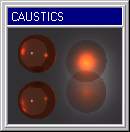Caustics (faked caustics)
· Light that travels through transparent objects, certainly has an effect in these objects shadows too.

|
· With »caustics« you can determine, whether a »focus- like« light-flash should appear in the shadow (see picture). It is important to know, that this feature is not really (and not exactly) calculated according to physical laws.
|
· It is merely a »trick«, done by POVRAY. Therefore caustics is often referred to as »faked-caustics«. Nevertheless, using this function can produce very astonishing effects. Lower caustics-values will produce bigger focus-spots.
Fade-distance, fade-power

|
· So far, when we talked about light, that is travelling through objects, we did not consider, that the density of the objects material could attenuate the light- beam
. You'll probably be glad to hear, that someone else did think about that.
|
| |
· Using the »fade-distance« and »-power«-values lets you A - set the distance, after which the attenuation begins and B - set the power of this attenuation.
Brilliance

|
· Last but not least, there is an option, to apply more »shinyness« to an objects surface.
· This option is called »brilliance« and results in a very smooth and metallic glance. Brillinace is best used combined with »phong«- or »specular«-highlights.
|
· After so much facts on textures, you will probably think »Praise the Lord that it's over!«.
· Anyway, you better »pray to the Lord«, cos these were just the basic facts of the texture-options- description and there is still more to come. But for now, this will do. You have seen the major texture- modifiers and you can (or »should«) now start to experiment with them.
· Because the »finish«-parameters have lots to do with light, we have prepared a quick-info-page. Click here to join this summaray.
|

